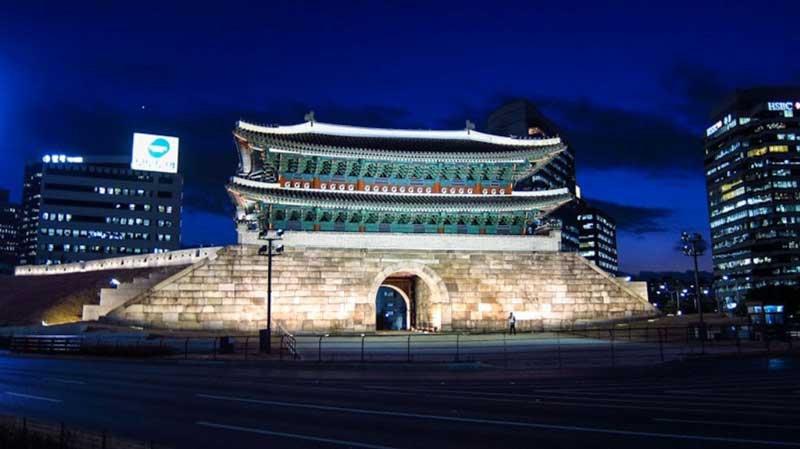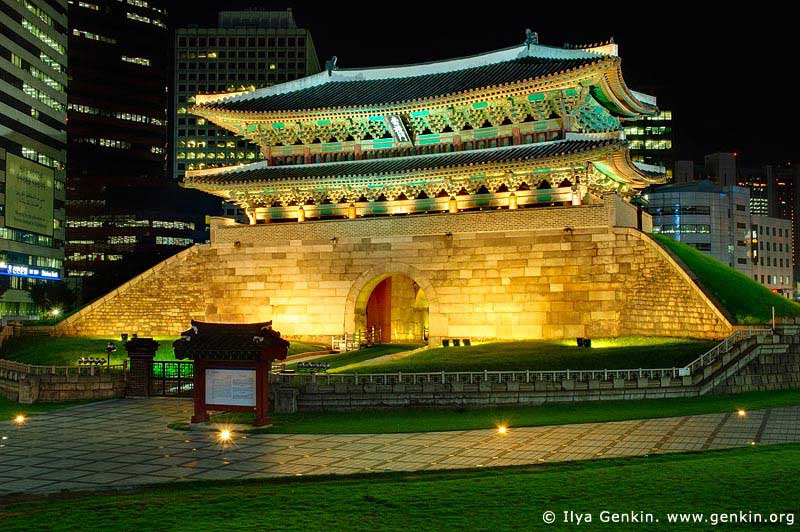
Located in the heart of Seoul, Sungnyemun is one of the eight gates of the 18`2 km long and 20 feet tall fortress wall that surrounded the city of Seoul in South Korea during the Joseon Dynasty. Popularly known as Namdaemun, for its proximity to the Namdaemun Market, the unusual pagoda-style gateway was first built in the last year of King Taejo of Joseon’s reign in 1398 and subsequently rebuilt in 1447. Later, with the expansion of the city, five more gates were constructed along the wall that originally served to save the city from the possible invaders and Siberian tigers that once roamed the area. The ancient gateway dating back to the 14th century, with the unusual ornate structure resembling a pagoda on a solid fortress wall, became a symbol of the country and was designated as the first National Treasure.
Originally built using wood and stone, construction of Sungnyemun began in 1395 and completed within three years, in 1398. There is a column on the top of a platform, raising the roof that separates the upper and the lower stories of the building. A passageway for traffic is located at the east and west ends of the gate.

Unlike the other gates, the name of Sungnyemun is written vertically in its tablet. According to the famous accounts of the Grand Prince Yangnyeong, who was the first son of the third Joseon King Taejong, the capital city was built by the first Joseon king Lee Seong-Gye. As the meaning of Sungnyemun is fire, which is from the harmony of the Five Elements, he believed that one day fire would grab his Gyeongbokgung Palace, as well as the capital city, since according to feng-shui principles the Mount Gwanaksan of Seoul was also shaped like fire. However, if written vertically, the Chinese character ‘fire’ looks as if it is providing protection.
Gradually, with the increase of population and traffic, the ancient surrounding walls seemed to create a problem for the easy and smooth flow of daily life. Finally, to make the traffic system more efficient and expand the limit of a modernized Seoul, the walls were torn down in 1907. The gate was also closed to the public in the same year, after the authority constructed an electric tramway nearby.

The age-old Namdaemun was extensively damaged during the Korean War between 1950 and 1953 and the consequent restoration work began in 1961, which was successfully ended with a completion ceremony held on 14 May 1963. Later, it was renovated again in 2005, when a lawn was created around the gate, before being opened once again to the public with much fanfare on 3 March 2006.

Unfortunately, a fire broke out at the top of the Namdaemun gate at about 8.50 pm on 10 February 2008, which severely damaged the wooden structure. At first, it was thought that the blaze could be controlled easily. But despite the best efforts of more than 360 firefighters, the fire roared out of control again after midnight and finally destroyed the whole structure. Initially, it was considered an accident. But later it was revealed that it was a deliberate act of arson, as a ladder, paint thinner, and two disposable lighters were found at the scene.
Soon a 69-year-old man identified as Chae Jong-gi was arrested on suspicion, who confessed within half an hour that he had sprayed paint thinner on the floor of the structure and then set fire to it, as he was upset about not being paid in full for the land he had sold to developers and believed it would be the easiest way to attract the attention of the law-makers. The huge restoration work that began in 2009 was completed on 29 April 2013 and the gate was officially reopened to the public on 5 May 2013, after a five-year restoration period.